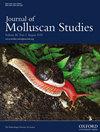Closing the gap: a new phylogeny and classification of the chemosymbiotic bivalve family Lucinidae with molecular evidence for 73% of living genera
IF 1.2
4区 生物学
Q2 MARINE & FRESHWATER BIOLOGY
引用次数: 1
Abstract
New molecular phylogenies of the chemosymbiotic bivalve family Lucinidae, using 18S rRNA, 28S rRNA and cytochrome b genes, include species from genera not previously analysed. Notable additions from Myrteinae are sequences from Rostrilucina, Solelucina and Taylorina species, species of Ustalucina, Gonimyrtea from Leucosphaerinae and additional species of Ctena, Codakia, Lucinoma and Divalucina from Codakiinae. New sequences of Lucininae include the type species of Parvilucina (P. tenuisculpta), Liralucina, Falsolucinoma, Easmithia, Jallenia, Radiolucina and Cardiolucina as well as samples of Loripes orbiculatus from multiple localities. Five major clades, defined as subfamilies, are recognized: Pegophyseminae, Myrteinae, Leucosphaerinae, Codakiinae and Lucininae. Two branches, Fimbriinae and Monitilorinae, are represented by single species. Pegophyseminae are an extremely long-branched group with a sister-group relationship to Leucosphaerinae, while Codakiinae are a sister clade to the Lucininae. In various gene trees, the position of Myrteinae is unstable in relation to Pegophyseminae + Leucosphaerinae, Monitilorinae and Fimbriinae. The Myrteinae are not well resolved, with an ambiguous correlation of molecular and morphological characters. Codakiinae now include Divalucina cumingi, shown to be related to Lucinoma rather than Divaricella and Divalinga of the Lucininae. Leucosphaerinae are a well-supported clade but morphologically disparate, with the positions of Gonimyrtea and Callucina unresolved. Several molecularly distinct subclades are recognized within the Lucininae, especially the Lucinisca, Loripes and Parvilucina groups. Parvilucina species are paraphyletic with P. tenuisculpta, the type species, distinct from the western Atlantic species. Codakia, Ctena and Pegophysema have pan-tropical distributions with former connections disrupted by vicariant events of the closure of the eastern Tethyan and Central American Seaways. Species of Radiolucina, Pleurolucina and Lucinisca are present on either side of the Isthmus of Panama. A new classification of the 96 living lucinid genera is presented, providing a framework for future studies of systematics, ecology, biogeography and bacterial symbioses.缩小差距:化学共生双壳类Lucinidae科新的系统发育和分类,包括73%现存属的分子证据
利用18S rRNA、28S rRNA和细胞色素b基因进行的化学共生双壳纲Lucinidae的新分子系统发育包括以前未分析的属的物种。Myrteinae中值得注意的添加是来自Rostrilucina、Solelocina和Taylorina物种的序列,来自Leucosphaerinae的Ustalucina、Gonimyrtea物种,以及来自Codakiinae的Ctena、Codakia、Lucinoma和Divalucina的附加物种。Lucininae的新序列包括Parvilucina(P.tenisculpta)、Liralucina、Falsolucinoma、Easmithia、Jallenia、Radiolucina和Cardiolucina的模式种,以及来自多个地点的Loripes orbiculatus的样本。五个主要的分支,被定义为亚科,被公认为:鬼臼亚科,Myrteinae,Leucosphaerinae,Codakiinae和Lucininae。以单一物种为代表的有两个分支,即毛伞科和莫尼蒂洛林科。Pegophyseminae是一个非常长的分支群,与Leucosphaerinae有姐妹群关系,而Codakiinae是Lucininae的姐妹分支。在各种基因树中,Myrteinae的位置与鬼臼菌科+白孢菌科、Monitilorinae和Fimbriinae的关系是不稳定的。Myrteinae的分子和形态特征之间的相关性不明确,因此不能很好地分辨。Codakiinae现在包括Divalucina cumingi,被证明与Lucinoma有关,而不是Lucininae的Divaricella和Divalinga。白孢菌纲是一个得到充分支持的分支,但在形态上不同,Gonimyrtea和Callucina的位置尚未确定。在Lucininae中发现了几个分子上不同的亚基,特别是Lucinisca、Loripes和Parvilucina组。Parvilucina物种与模式物种P.tenisculpta是异系的,与西大西洋物种不同。Codakia、Ctena和Pegophysema具有泛热带分布,以前的联系因德提斯东部和中美洲航道关闭的替代事件而中断。在巴拿马地峡的两侧都有放射露西娜、胸膜露西娜和露西妮斯卡的物种。提出了96个活虫属的新分类,为今后系统学、生态学、生物地理学和细菌共生体的研究提供了框架。
本文章由计算机程序翻译,如有差异,请以英文原文为准。
求助全文
约1分钟内获得全文
求助全文
来源期刊

Journal of Molluscan Studies
生物-动物学
CiteScore
3.00
自引率
8.30%
发文量
36
审稿时长
3 months
期刊介绍:
The Journal of Molluscan Studies accepts papers on all aspects of the study of molluscs. These include systematics, molecular genetics, palaeontology, ecology, evolution, and physiology. Where the topic is in a specialized field (e.g. parasitology, neurobiology, biochemistry, molecular biology), submissions will still be accepted as long as the mollusc is the principal focus of the study, and not incidental or simply a convenient experimental animal. Papers with a focus on fisheries biology, aquaculture, and control of molluscan pests will be accepted only if they include significant advances in molluscan biology. While systematic papers are encouraged, descriptions of single new taxa will only be considered if they include some ‘added value’, for example in the form of new information on anatomy or distribution, or if they are presented in the context of a systematic revision or phylogenetic analysis of the group.
 求助内容:
求助内容: 应助结果提醒方式:
应助结果提醒方式:


